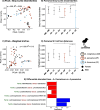The gut microbiota of three avian species living in sympatry
- PMID: 39574002
- PMCID: PMC11580620
- DOI: 10.1186/s12862-024-02329-9
The gut microbiota of three avian species living in sympatry
Abstract
Background: Evolutionary divergence and genetic variation are often linked to differences in microbial community structure and diversity. While environmental factors and diet heavily influence gut microbial communities, host species contributions are harder to quantify. Closely related species living in sympatry provide a unique opportunity to investigate species differences without the confounding effects of habitat and dietary variation. We therefore compared and contrasted the gut microbiota of three sympatric plover species: the widespread Kittlitz's and white-fronted plovers (Anarhynchus pecuarius and A. marginatus) and the endemic and vulnerable Madagascar plover (A. thoracicus).
Results: We found no significant differences in the beta diversity (composition) of the gut microbiota of the three species. However, A. thoracicus exhibited higher intraspecific compositional similarity (i.e. lower pairwise distances) than the other two species; this pattern was especially pronounced among juveniles. By contrast, microbial alpha diversity varied significantly among the species, being highest in A. pecuarius, intermediate in A. marginatus and lowest in A. thoracicus. This pattern was again stronger among juveniles. Geographical distance did not significantly affect the composition of the gut microbiota, but genetic relatedness did.
Conclusion: While patterns of microbial diversity varied across species, the lack of compositional differences suggests that habitat and diet likely exert a strong influence on the gut microbiota of plovers. This may be enhanced by their precocial, ground-dwelling nature, which could facilitate the horizontal transmission of microbes from the environment. We hypothesise that gut microbiota diversity in plovers primarily reflects the ecological pool of microbiota, which is subsequently modified by host-specific factors including genetics. The reduced microbial and genetic diversity of the endemic A. thoracicus may hinder its ability to adapt to environmental changes, highlighting the need for increased conservation efforts for this vulnerable species.
Keywords: Endemic; Genetics; Gut microbiota; Holobiont; Madagascar; Plovers.
© 2024. The Author(s).
Conflict of interest statement
Declarations. Ethics approval and consent to participate: Sampling of the three species of Madagascar plovers was approved by the Direction des Aires Protégées, des Ressources Naturellement Renouvelables et des Ecosystèmes from Madagascar (permits n $$^{\circ }$$ ∘ 386/21 and 054/21/MEDD/SG/DGGE/DAPRNE/SCBE.Re). Consent for publication: Not applicable. Completing interests: The authors declare no competing interests.
Figures





Similar articles
-
Variation in nest survival of three species of tropical plovers in Madagascar with clutch size, age of nest, year and El Niño effect.Ecol Evol. 2024 Sep 16;14(9):e70269. doi: 10.1002/ece3.70269. eCollection 2024 Sep. Ecol Evol. 2024. PMID: 39286315 Free PMC article.
-
Contrasting genetic diversity and population structure among three sympatric Madagascan shorebirds: parallels with rarity, endemism, and dispersal.Ecol Evol. 2015 Mar;5(5):997-1010. doi: 10.1002/ece3.1393. Epub 2015 Jan 23. Ecol Evol. 2015. PMID: 25798218 Free PMC article.
-
Diet-induced microbiome shifts of sympatric overwintering birds.Appl Microbiol Biotechnol. 2021 Aug;105(14-15):5993-6005. doi: 10.1007/s00253-021-11448-y. Epub 2021 Jul 17. Appl Microbiol Biotechnol. 2021. PMID: 34272578
-
Global landscape of gut microbiome diversity and antibiotic resistomes across vertebrates.Sci Total Environ. 2022 Sep 10;838(Pt 2):156178. doi: 10.1016/j.scitotenv.2022.156178. Epub 2022 May 23. Sci Total Environ. 2022. PMID: 35618126 Review.
-
The potential role of the gut microbiota in shaping host energetics and metabolic rate.J Anim Ecol. 2020 Nov;89(11):2415-2426. doi: 10.1111/1365-2656.13327. Epub 2020 Sep 28. J Anim Ecol. 2020. PMID: 32858775 Review.
References
-
- Rosenberg E. Microbiomes: Current Knowledge and Unanswered Questions. Cham: Springer Nature Switzerland AG; 2021.
-
- Grond K, Sandercock BK, Jumpponen A, Zeglin LH. The avian gut microbiota: community, physiology and function in wild birds. J Avian Biol. 2018;49(11): e01788.
MeSH terms
Grants and funding
- 316099922/Deutsche Forschungsgemeinschaft
- 316099922/Deutsche Forschungsgemeinschaft
- 316099922/Deutsche Forschungsgemeinschaft
- 316099922/Deutsche Forschungsgemeinschaft
- 316099922/Deutsche Forschungsgemeinschaft
- 316099922/Deutsche Forschungsgemeinschaft
- 316099922/Deutsche Forschungsgemeinschaft
- 316099922/Deutsche Forschungsgemeinschaft
- 316099922/Deutsche Forschungsgemeinschaft
- 316099922/Deutsche Forschungsgemeinschaft
- 396780709/Deutsche Forschungsgemeinschaft,
- 396780709/Deutsche Forschungsgemeinschaft,
- 396780709/Deutsche Forschungsgemeinschaft,
- 396780709/Deutsche Forschungsgemeinschaft,
- 396780709/Deutsche Forschungsgemeinschaft,
- 396780709/Deutsche Forschungsgemeinschaft,
- 396780709/Deutsche Forschungsgemeinschaft,
- 396780709/Deutsche Forschungsgemeinschaft,
- 396780709/Deutsche Forschungsgemeinschaft,
- 396780709/Deutsche Forschungsgemeinschaft,
LinkOut - more resources
Full Text Sources
